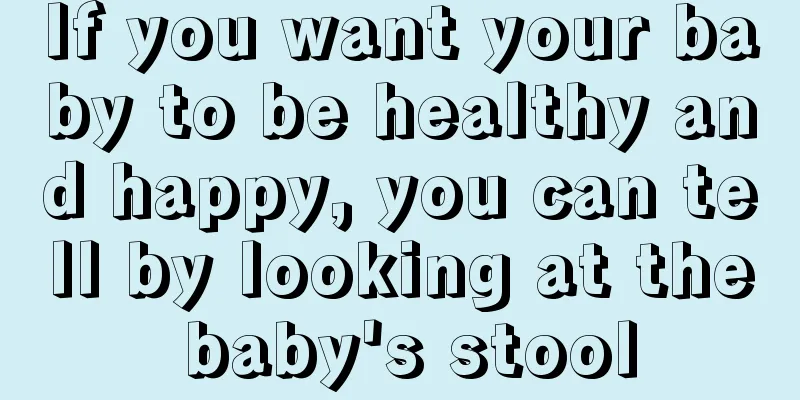Can the father take care of the baby alone? How can the father take care of the baby?

|
I don't know if it's spring that makes me feel good. I recently saw a group of photos of father and son. They are so cute. The father doesn't spend as much time with the baby as the mother. If the mother is not at home, the poor baby will be abused by the father. Can the father take care of the baby? Here are some tips for the father to take care of the baby. Let's take a look! How to take care of children?1. Before the father picks up the babySay hello to your baby first. The familiar voice of your father will make him or her feel safe. When your baby hears your father's kind words, he or she will not feel disgusted when you move his or her body. 2. When dad puts the baby downOne hand supports the baby's head and neck, and the other hand supports the buttocks, and both hands slowly put the baby on the bed. Then, you pull out the hand under the buttocks first, lift the baby's head slightly, and then gently pull out the hand supporting the head and neck, and put the baby's head on the bed with both hands. 3. 8 weeks before the baby is bornBabies cannot control their own heads and muscles, so dads must hold their bodies and necks when moving the baby, and do not let their heads and limbs lose support and droop. 4. Dad holds the baby horizontallyWhen the baby is lying on his back, the father can reach his (her) lower back and buttocks with one hand, and hold the lower part of his (her) head and neck with the other hand, slowly pick him (her) up, and then carefully turn his (her) head and put it in the crook of his arm. The baby will feel very safe. When the baby is lying face down, you can hold the baby's body with both hands and let him (her) lie on your arms. 5. Dad reports baby verticallyYou can let the baby lean on your shoulder, put one hand under his (her) hips to support the weight, and use the other hand to hold his (her) head and hold him (her) upright. Babies like this very much. When the baby is a little older, dad can let the baby lean his (her) back against your chest, support the baby's hips with one hand, and wrap the baby's chest with the other hand. In this way, the baby's face is facing forward, the field of vision is wider, and the baby can see the world early. 6. Give your baby a bathThe birth of a baby brings endless joy to the whole family. New fathers will find many fun tasks, and bathing the baby is the most pleasant one. Benefits of bathing: It can make baby's skin clean and comfortable; accelerate baby's blood circulation and promote growth and development; enhance baby's resistance and prevent diseases; promote baby's sense of touch and brain development; facilitate observation of baby's overall condition and early detection of lesions. Specific requirements: The room temperature for bathing should be between 26 and 28 degrees Celsius and should not be lower than 24 degrees Celsius. A room temperature that is too low can easily cause the baby to catch a cold or even pneumonia. The temperature of the bath water should be between 39 and 41 degrees Celsius, and you can also judge by whether the inside of an adult's arm feels hot when placed in the water. The number of baths can be determined according to weather and family conditions. Generally, take a bath once a day in summer and 1 to 2 times a week in winter. 7. Change your baby’s diaperThe baby's bladder is very small and will often wet the diaper. Once you find the diaper is wet, you should change it at any time. Choose diapers. When choosing diapers for your baby, dads must pay attention to choosing diapers that are soft and absorbent. There are two types of diapers: cloth diapers, which have good breathability; and disposable diapers, which are suitable for use at night and when going out. Diaper size. Cloth diapers come in different sizes, and dads can fold them themselves or make them the right size according to the baby's needs. Diapers are divided into newborn and infant diapers. There are large, medium and small models. There are also sizes based on the baby's weight and age. 8. Diaper changing methodDad lifts the baby's feet, folds the diaper upwards to cover the contamination inside, wipes the feces on the buttocks with a wet sanitary towel or wet tissue, and then removes the dirty diaper. Prepare warm water, dad rinses the baby's buttocks with water, then uses a soft towel to absorb the water, and applies talcum powder or skin care oil or skin care lotion. Dad puts the clean diaper under the baby's buttocks at waist level, presses one end of the diaper with one hand, and opens the tape with the other hand, pulls it forward, and sticks it to the front, parallel to the upper edge of the diaper; use the same method to stick the other side, making sure the diaper fits tightly against the baby's legs and does not twist to one side. Do not let the diaper cover the baby's navel. Dad can fold the diaper covering the navel downwards to keep the navel dry and clean. 9. Take care of your navel properlyFathers must master the process of umbilical cord healing so that they can find and solve problems in time. After the baby is born, the umbilical cord is cut, leaving a white stump. The stump quickly turns brown, and then gradually dries and becomes thinner, becoming a black remnant until it falls off. It usually falls off about 7 days after birth, but the umbilical cord of some newborns can fall off as late as 2 weeks after birth. When the umbilical cord first falls off, the wound is slightly red and slightly moist, with a small white circle of about 2 mm in diameter in the middle. After a few days, the wound will completely dry and heal. As the umbilical cord blood vessels degenerate and contract, the skin is pulled to form a depression (that is, the "belly button"). Before the umbilical cord falls off and heals, and within a few days after the umbilical cord falls off, the stump of the umbilical cord is a wound with no skin covering it, and the blood vessels in the umbilical cord are not completely closed. Sometimes there is bleeding. In addition, the depression of the umbilical cord is prone to water and dirt accumulation, and it is not easy to dry. It is a good place for bacteria to breed, and omphalitis is prone to occur. Omphalitis can further expand the inflammation through the blood vessels in the umbilical cord, and even cause sepsis. 10. When to use a pillowBecause the S-shaped physiological curvature of the spine of newborn babies has not yet formed and their heads are relatively large, newborn babies do not need pillows. Because a pillow that is too high is not conducive to the formation of the curvature of the baby's spine and neck, and even affects the smoothness of the respiratory tract. At least 3 months later, the baby needs a small pillow. The length of the pillow should be equal to or slightly wider than the baby's shoulder width, and slightly longer than the head. The pillow core should be of appropriate hardness and thickness, generally about 3 cm (as the baby grows, the pillow should be appropriately increased). Pillowcases and pillow covers should be made of pure cotton, and they should also be washed and dried frequently. 11. Sleeping: Keep your baby comfortable and safe* Let the baby lie on his side or back, cover him with a small quilt, not a duvet with a loose lining. After the baby is 5 to 6 months old, you can put a cushion next to him to prevent him from rolling under the bed. * Check the room temperature, the ideal temperature is 18℃~22℃. *To make it easier to take care of your baby, you can place the crib next to your bed. Become an experienced dad: Is your baby crying? Put your clean little finger into his mouth. If he just wants to suck, he will "hold" your finger; if he is having a tantrum, he will cry as soon as you put him down! 12. Diet: Breastfeeding*Smooth a spoonful of milk powder and add appropriate amount of warm water according to the preparation instructions. * Loosen the nipple ring, let in a little air, and tighten it again. Drop a few drops of milk on your wrist, making sure it is not too hot. *Find a comfortable sitting position with your back padded. Let your baby's head rise so that he can suck better and it helps digestion. *Remember, after feeding, hold your baby upright to allow him to burp. Become an experienced father: Prevent your baby from taking in too much air, otherwise it will cause intestinal cramps and your baby will be in pain. If intestinal cramps occur, gently massage your baby's abdomen to relieve the pain. |
<<: How to treat bronchitis in children?
>>: Can pregnant women eat pomelo?
Recommend
Does the age of the couple affect the success rate of artificial insemination?
Although artificial insemination is a way to trea...
How to retrieve eggs for artificial insemination? How to retrieve sperm for artificial insemination?
Artificial insemination is a method of preparing ...
Can baby clothes be washed in a washing machine? It is best to wash by hand before the age of 3
It is best to wash baby's clothes by hand bef...
How to wean your baby? Mom has a trick
After nearly two and a half years of exclusive br...
Children's reading enlightenment: 6 skills to help you advance smoothly
If a child's interest in reading is not estab...
Sharing of successful experience in preparing for pregnancy
Young couples who want children have tried their ...
Is it hot to have confinement in October? Is it good to have confinement in October?
Confinement is a big deal for women. A good confi...
How long after giving birth can you lose weight? How to lose weight after giving birth
Your body shape will be out of shape after giving...
What can you eat to relieve vomiting during pregnancy? In what situations should pregnant women not touch their bellies casually?
Many pregnant women will experience nausea, vomit...
How to make housework fun for kids
When children grow up, parents should let them he...
How to enlarge breasts after childbirth? What products can quickly enlarge breasts?
The breasts of postpartum women will sag and defo...
How long does it take for Tianxi Pills to take effect? How long does it take for Tianxi Pills to become pregnant?
Many people take Tianxi Pills but don’t know much...
Can I eat Sanzi during the confinement period? Can I eat Sanzi during the confinement period?
Although all mothers have completed their mission...
Can black toothpaste remove blackheads? Is black toothpaste effective in removing blackheads?
Black toothpaste can be used to wash your face, b...
How to dissipate heat when a baby has a fever?
The body temperature of babies is higher than tha...









